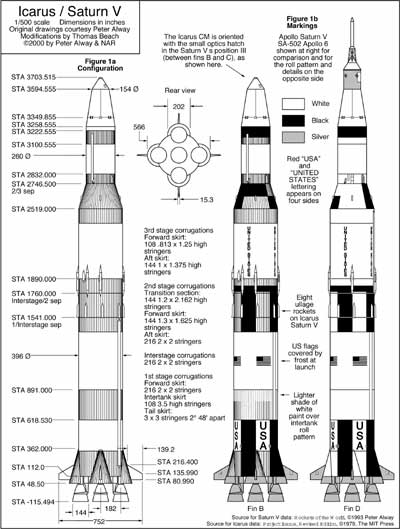Giant bombs on giant rockets: Project IcarusLaunch Complex 39CThe Icarus plan required a total of nine Saturn V rockets. Three were test flights and the remaining six were interceptors. At the time, NASA planned on having only six Saturn V’s available by April 1968, so the production schedule would have to be dramatically increased. In addition, another launch pad would have to be built at Cape Kennedy. Launch Complex 39C would have to be built in order to enable the high flight rate needed for the Saturn launches, all of which had to get off the ground in six weeks. In addition to the nine Saturn Vs, the Icarus plan called for five Atlas Agena rockets carrying modified versions of the Mariner 2 deep space probe. Known as the Intercept Monitoring Satellite (IMS), these probes would be used to observe the actual detonation of the nuclear bombs when they reached the asteroid. Very little was known about how nuclear weapons would actually behave in space, let alone how the blast would affect an asteroid, and so the IMS was considered vital to the mission.
In late February 1968, the first IMS spacecraft would lift off atop its Atlas Agena booster. It would linger in Earth orbit only a short time before being sent on its way to rendezvous with Icarus. A little over a month later, Interceptor One would thunder aloft on 33 million newtons of thrust. After a coast of one orbit or less, the S-IVB stage would fire, boosting the Icarus spacecraft out of Earth orbit and toward the asteroid. Soon after, the adapter shroud panels would peel back like the petals of a flower and the Icarus spacecraft with its 100-megaton bomb would separate. Its Service Propulsion System engine would fire, adding more velocity to the spacecraft. After a coast of approximately 60 days, with several course corrections along the way, an optical sensor aboard the spacecraft would acquire Icarus only three hours before rendezvous. The spacecraft then entered the “terminal phase.” Four minutes before rendezvous the radar system would begin to supply range information for making final correction maneuvers. At five seconds before impact, a fusing radar would acquire the asteroid and arm the bomb. If all went as planned, detonation would occur within 100 feet of the surface of Icarus along the sunlit edge. The resulting explosion would either fragment or deflect the asteroid off its collision course. From Icarus to NEARThe planners proposed six bombs for the mission. But they faced huge unknowns. The biggest problem was that nobody knew exactly what asteroids in general, and Icarus in particular, were made of. Was Icarus dense or light? Exactly how big was it? How was it shaped? In fact, thirty-seven years later we are not in a much better situation. Despite studying several asteroids up close with robotic probes and even landing on one with the NEAR spacecraft, planetary scientists are still unsure how they’re composed. One theory, known as the “rubble pile,” is that many asteroids are not really rocks, but bundles of rocks and dust. Hitting one with a nuclear explosion might accomplish little, as it would absorb the blast and not move very much. Compare trying to push a rock across the ground with one finger with about pushing a pile of peanuts across the ground with a finger.
Furthermore, nobody was sure how a nuclear bomb would act in space or how it would affect Icarus—and because nuclear testing in space was effectively banned in the 1960s we still do not know. There was no way to get everything right on the first try and so several bombs would have to be detonated before planners even began to understand what they were doing. The Icarus project’s legacy was primarily to spawn a lousy 1970s movie called Meteor! (complete with exclamation mark) which was not only scientifically ridiculous, but committed the grave sin of covering the beautiful Natalie Wood in mud. Saving planet EarthThere are new ideas about how to do defend against deadly asteroids, but they require long advance warning. One current proposal comes from the awkwardly-named B612 Foundation. Their recommendation is to develop a spacecraft similar to that planned for the Jupiter Icy Moons Orbiter (JIMO) and send it to intercept, and move, a known asteroid. The spacecraft would settle down on the surface and then use its ion propulsion engine to alter the asteroid’s trajectory. This would be a demonstration mission, proving that we could defend the planet if needed, and would have an additional science benefit. But any actual saving of planet Earth would require detecting a killer asteroid a decade or more in advance. Asteroid defense has managed to overcome much of the giggle factor that used to plague it. But it is still not respectable enough in Congress to get even relatively small amounts of funding to search for killer rocks with Earth’s name on them. It will probably be decades before it is seriously considered by the American government, unless a near miss by another asteroid scares some people into action. The guys in the B612 Foundation could start by changing their name. “The Icarus Foundation” has a certain ring to it. Gently pushing a killer rock away is not as sexy as smacking it with giant nukes, but it is far more realistic. And it may be achievable with near-term technology. Home |
|
